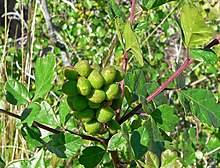Rhus trilobata
| Rhus trilobata | |
|---|---|

| |
| Green berries | |
| Scientific classification | |
| Kingdom: | |
| (unranked): | |
| (unranked): | |
| (unranked): | |
| Order: | |
| Family: | |
| Genus: | |
| Species: | R. trilobata
|
| Binomial name | |
| Rhus trilobata | |
Rhus trilobata is a shrub in the sumac genus (Rhus) with the common names skunkbush sumac,[1] sourberry, skunkbush, and three-leaf sumac. It is native to the western half of Canada and the Western United States, from the Great Plains to California and south through Arizona extending into northern Mexico. It can be found from deserts to mountain peaks up to about 7,000 feet (2,100 m) in elevation.
Distribution
Rhus trilobata grows in many types of plant communities, such as the grasslands east of the Rocky Mountains, mountainous shrubland, pine, juniper, and fir forests, wetlands, oak woodlands, and chaparral. The plant is destroyed above ground but rarely killed by wildfire, and will readily sprout back up in burned areas.
Description
This Rhus species closely resembles other members of the genus that have leaves with three "leaflets" ("trifoliate" leaves). These include Rhus aromatica, native to eastern North America, and western poison-oak. The shape of the leaflets and the habit of the shrub make this species, like some other Rhus, resemble small-leafed oaks (Quercus).
The Rhus trilobata leaves have a very strong scent when crushed. The aroma is medicinal or bitter, disagreeable enough to some to have gained the plant the name skunkbush. The leaves are green when new and turn orange and brown in the fall. The twigs are fuzzy when new, and turn sleek with age. The flowers, borne on small catkins ("short shoots"), are white or light yellow. Edible fruit, the plant yields hairy and slightly sticky red berries which have an aroma similar to limes and a very sour taste. The acidity comes from tannic and gallic acids. The flowers are animal-pollinated and the seeds are dispersed by animals that eat the berries. The shrub also reproduces vegetatively, sending up sprouts several meters away and forming thickets.
Uses
The skunkbush sumac has historically been used for medicinal and other purposes. The bark has been chewed or brewed into a drink for cold symptoms, the berries eaten for gastrointestinal complaints and toothache, and the leaves and roots boiled and eaten for many complaints. The leaves have also been smoked. The flexible branches were useful and sought after for twisting into basketry and rugs. The berries, although sour, are edible.[2] They can be baked into bread or mixed into porridge or soup, or steeped to make a tea or tart beverage similar to lemonade.
It is sometimes planted for erosion control and landscaping, and is a plant used for reclaiming barren land stripped by mining.
The Zuni people, Navajo, and tribes in the area use the stems with the bark removed to make baskets.[3]
References
- ^ NRCS. "Rhus trilobata". PLANTS Database. United States Department of Agriculture (USDA). Retrieved 21 October 2015.
- ^ Laferrière, Joseph E., Charles W. Weber and Edwin A. Kohlhepp. 1991a. Use and nutritional composition of some traditional Mountain Pima plant foods. Journal of Ethnobiology 11(1):93-114.
- ^ Stevenson, Matilda Coxe 1915 Ethnobotany of the Zuni Indians. SI-BAE Annual Report #30 (p. 81)
Casebeer, M. (2004). Discover California Shrubs. Sonora, California: Hooker Press. ISBN 0-9665463-1-8
External links
- Rhus
- Fiber plants
- Flora of North America
- Natural history of the California Coast Ranges
- Natural history of the Santa Monica Mountains
- Natural history of the Central Valley (California)
- Natural history of the Peninsular Ranges
- Bird food plants
- Plants used in traditional Native American medicine
- Plants used in Native American cuisine
